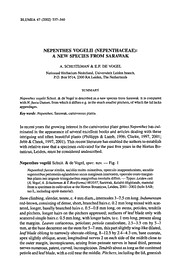
Nepenthes Vogelii (Nepenthaceae): a new species from Sarawak PDF
Preview Nepenthes Vogelii (Nepenthaceae): a new species from Sarawak
BLUMEA 47 (2002) 537-540 NepenthesVogelii (Nepenthaceae): a new species from Sarawak A. Schuiteman & E.F. de Vogel Nationaal Herbarium Nederland,UniversiteitLeidenbranch, P.O. Box9514,2300 RALeiden,The Netherlands Summary NepenthesvogeliiSchuit.& deVogelis described as anewspecies fromSarawak. Itis compared withN.fuscaDanser,from whichitdifferse.g.inthemuch smallerpitchers,ofwhichthe lidlacks appendages. Key words'.Nepenthes,Sarawak,carnivorous plants. Inrecentyearsthegrowing interestinthecarnivorousplantgenusNepenthes has cul- minatedintheappearanceofseveralexcellentbooks andarticles dealing withthese intriguing andoftenbeautifulplants (Phillipps & Lamb, 1996;Clarke, 1997,2001; Jebb&Cheek, 1997,2001).Thisrecent literaturehasenabledtheauthorstoestablish withrelativeeasethataspecimen cultivatedforthepastfive yearsintheHortus Bo- tanicus,Leiden,mustbe consideredundescribed. Nepenthes vogelii Schuit. & deVogel, spec. nov. —Fig. 1 Nepenthidi fuscaesimilis,ascidiismultominoribus,operculoinappendiculato,ascidiis superioribusperistomioeglandulososecusmargineminteriorem,operculoovatomargini- bus planisnecangustetriangularibusmarginibusinvolutis differt.—Typus:Leiden cult. (A.Vogel,A.Schuiteman&T.Roelfsema)981037,Sarawak,Kelabit Highlands,material from aspecimenin cultivationattheHortus Botanicus,Leiden,2001-2002 (holoSAR; isoL,includingspirit material). Stemclimbing, slender,terete,c. 4mmdiam.,internodes3-7.5cmlong. Indumentum red-brown,consistingofdense,short,branchedhairsc.0.2mmlong mixedwithscat- tered, longer, basally branchedhairsc.0.5-0.8 mmlong, onstems,petioles, tendrils andpitchers, longer hairsonthepitchers appressed; surfaces of leafbladeonly with scatteredsimple hairsc.0.5mmlong, withlonger hairs, toc. 1mmlong, presentalong the margins. Leaves coriaceous,petiolate; petiole canaliculate,2.5-3.5 cm by 5-7 mm, atthebasedecurrentonthestemfor5-7mm,thispartslightly wing-likedilated; leafbladeoblong to narrowly obovate-oblong, 8-12.5by 2.4-4.3cm,base cuneate, apexslightly oblique, acute;longitudinal nerves 2oneachsideofthemidribcloseto the outer margin,inconspicuous, arisingfrompennatenerves inbasalthird,pennate nervesnumerous, patent,curved,inconspicuous. Tendrilsaboutas longas thecombined petioleandleafblade,withacoilnearthemiddle.Pitchers, including thelid, greenish 538 BLUMEA Vol. 47, No. 3, 2002 Fig. 1.NepenthesvogeliiSchuit.&de Vogel.a.Stemwith upperpitcher;b. lowerpitcher; c.male inflorescence; d. male flower;e. detail ofperistome oflower pitcher; f.detail ofperistome of upper pitcher;g.crosssectionthroughperistomeofupperpitcher;h. lidofupper pitcher;detail of glandsonlower surface(Leiden cult. (A. Vogel,A.Schuiteman & T.Roelfsema)981037). A.Schuiteman & E.F.de Vogel:Nepenthes vogelii:anew speciesfrom Sarawak 539 creamwithdeepdullred-purple blotches, peristomelightyellow withmanyredstripes. Lowerpitchers cylindrical, gradually tapering to the base, atc. 1/3 abovethe base with a very slightly thickenedannular zone, broadly and weakly constricted inthe middle,only slightlywidenedtowardsthemouth,9-9.5 by 1.3-1.5cm,near themouth with or withouttwo very short fringed wings, the wings 1-7 mm long, c. 1.5 mm wide,thefringe segments2-3mmlong, 0.1-1.5mmapart;mouthbroadlyovate,ele- vatedtowardsthelid;peristome flattened-semicylindrical, c.2 mmwideinfront,c. 3 mmwideattheback, finelyribbed, theribs c.0.3mmapart,innermargindenticulate, with a gland betweenadjacent teeth, outer margin entire; lid orbicular, 1.2-1.5by 1.5-1.6cm,basecordate, apexbroadly rounded,both surfaces withoutappendages, nectarglandsofthelowersurfaceabsentinthecentreoralmostso, scatteredelsewhere, orbicular, rimmed, c.0.13mm across; spur2-3.5 mmlong,at2.5-3 mmbelowthe lid, unbranched.Upperpitchersinfundibuliform,graduallytapering toalong narrow base, 7.5-9by 2.5-2.7cm,withoutwings butwith two somewhatprominentridges; peristome flattened,4-5 mmwideinfront, 5-7mmwideattheback, finely ribbed, theribsc.0.25mmapart,innermargin weakly obtusely denticulate,eglandular, outer marginentire;lidovate,2-2.6by 1.5-1.9cm,base cordate,apexobtuse,bothsurfaces withoutappendages, nectarglands ofthelowersurfaceabsentinthecentre oralmost so, scatteredelsewhere,orbiculartoelliptic,rimmed,0.14-0.2mmacross; spur3-5 mm long, at2-4 mmbelow the lid, unbranched.Maleinflorescence 12.5 cm long, racemose, c.50-flowered;peduncle 4.5cmlong; pedicels 1-flowered,6-10mmlong, bracts absent; tepals elliptic, c.2.6 by 1 mm; androphore 2.3 mmlong,anther head c. 1.3 by 1.6mm. Femaleinflorescence, fruitandseednot seen. Distribution—Sarawak,KelabitHighlands (exactlocality withheldforconservation purposes). Ecology —Terrestrialinmoss inwetkerangas forestonwhitesand,altitude 1000m abovesea-level. Notes— 1.Asingle living specimen ofthisnewspecies was collectedin March 1997asasmallseedling fromanarea whereN. stenophylla Mast,was abundantand whereN. veitchiiHook.f. alsooccurred.AftersomeyearsincultivationattheLeiden HortusBotanicusitturnedouttobe verydifferentfromeitherofthesetwo species. In habitandintheoverall shape ofthestrongly dimorphic pitchers, N. vogelii can only becompared to N. fusca Danser. It differsfromthe latterin theconsiderably smal- lersize oftheupperpitchers (7.5-9cm long inN. vogelii, 11—21.5(—30) cmlong in N.fusca, fide Cheek & Jebb, 2001),but perhaps more significantly in the complete absenceofappendages onthepitcherlid, thedifferentdistributionofthenectar glands onthelowersurface ofthe lid, thealmostrudimentary or even lacking wings onthe lowerpitchers, andthelack ofglands along theinnermarginoftheperistome ofthe upperpitchers. Inaddition,thelidoftheupperpitchers inN.fuscaisnarrowlytriangular withinvolute margins, whileitis ovate with flatmargins inN. vogelii. 2.Thefactthatnomatureplants ofN. vogelii wereseen atthetypelocality mayin- dicatethat this species normally occurs as anepiphyte, inwhich case itcouldhave beenoverlooked.Ontheotherhand,itmayalsoimply thatitsoccurrence inkerangas vegetationisincidental,andthatitstypical habitatisinthesurrounding montane forest. A hybridorigin seems unlikely, as our new species shows notraceofintrogression fromthe locallyoccurring N. stenophylla andN. veitchii. 540 BLUMEA Vol. 47, No. 3, 2002 3.On the website ofa commercial nursery in Sarawak (Malesiana Tropicals) a plantthatisundoubtedly conspecific withN. vogeliiwasrecently (August, 2002)illus- tratedas 'Nepenthes spec. #4',withanaccompanying notestatingthatitwas"anewly discoveredandundescribedspecies occurringinmontanelimestoneforestinnorthern Borneo". 4.Thisspecies is namedafterMr. ArtVogel, greenhouse managerof theLeiden Hortus Botanicus, whoco-discovered and successfully cultivatedthis species. His skills as acultivatorofNepenthes species, Orchidaceae,andAmorphophallus, among manyotherplant groups,are secondtononeandhavebeen highly beneficialforbot- anists working onthesetaxa. ACKNOWLEDGEMENTS Theauthors would liketothankMs.AnitaWalsmitSachsforthefinedrawingandDr.J.F.Veldkamp (L)forkindlytranslatingthediagnosisintoLatin.ArtVogel,TinekeRoelfsema andAndreSchuite- manaregratefulforthe supportofthe SarawakForest Department,Kuching,whose staffshowed greatorganisationalskill inarrangingthe triptotheKelabit Highlandsin 1997 thatresulted inthe discovery ofN. vogelii, amongmany otherthings. REFERENCES Clarke,C. 1997.NepenthesofBorneo.NaturalHistory Publications (Borneo),Kota Kinabalu. Clarke,C. 2001. Nepenthes ofSumatra and Peninsular Malaysia. Natural History Publications (Borneo),KotaKinabalu. Jebb,M.& M.Cheek. 1997.Askeletalrevision ofNepenthes(Nepenthaceae).Blumea 42:1-106. Jebb,M.& M.Cheek. 2001.Nepenthaceae.Fl.Malesiana,ser.I, 15: 1-157. Phillipps, A.&A.Lamb. 1996.Pitcher-plantsofBorneo. Natural History Publications (Borneo), Kota Kinabalu.
